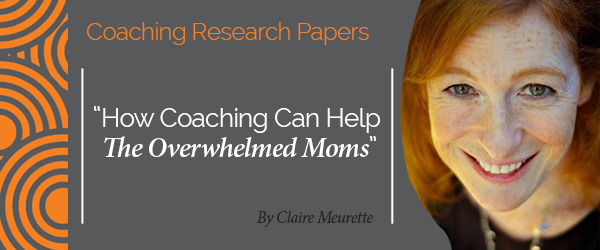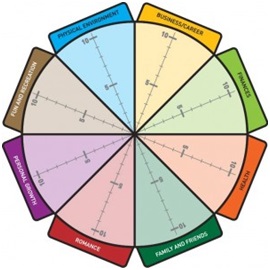
Research Paper By Claire Meurette
(Cross-cultural Coach, FRANCE)
 It seems that there is an epidemic of overwhelmed moms. Everywhere you look, everyone you listen, every magazine you pick up will give a glimpse of the 21st century life of moms, and the picture is not pretty.
It seems that there is an epidemic of overwhelmed moms. Everywhere you look, everyone you listen, every magazine you pick up will give a glimpse of the 21st century life of moms, and the picture is not pretty.
Today’s women -especially moms- supposedly have it all -or want it all- i.e. the family AND the career. But as Western society evolved from pre-60s structures where the model was women at home doing housework and taking care of the children and men earning the family income outside of the home, to a different current model where both men and most women work outside the house (Stay-at-home moms or homemakers being a disappearing breed). Despite the obvious changes in society, old structures remain (studies have shown that women are still mostly in charge of the children and the housework regardless if they work outside from home and even if men are slowly getting more involved) while new structures are coming in place (women working outside their home).This phenomenon is also known as the “double shift”. Adding to that a change/evolution in the familial structure (and the increase of single parent families -usually where the woman is the single earner-), women face specific challenges that often drive them to a stage of being completely overwhelmed because women often feel that they have to do it all and don’t see a way out.
This case study with focus on two of these modern moms -Elsa and Anna (names have been changed for confidentiality)- and how coaching helped them addressing these challenges.
Despite being geographically divided (they live on different countries/continents) Elsa and Anna have a lot in common:
Case study #1:
 Elsa. From the washing machine to
Elsa. From the washing machine to
everything is more simple.
Background:
Elsa is an expat, a mother of two and a middle-management public servant for a European governmental agency. The job is well paid but extremely challenging/demanding and often demands long works hours. She works in a cultural environment where face-time and long hours are regarded as a sign of being a good worker. Despite internal policies encouraging part-time and family leave -especially for women/moms- the cultural pressure makes it hard for women who also want an fulfilling career to actually take advantage of these policies. Often the ones who take advantage of these policies are viewed as second-class workers and it’s often harder for them to move up in the internal career ladder.
When we started her coaching sessions Elsa was working long hours, was extremely stressed out and was aware that she did not have any patience and energy for her children when she was getting home after a long day. She could not find time to take care of herself either. She was completely consumed by her work. At the same time she was not satisfied at all with her work. and was considering quitting. The combination of all these elements and the increase of her stress levels started to impact negatively her interaction with others: family members, co-workers, friends etc. Soon she found herself in a negative spiral and did not know how to get out of it. During her first session Elsa stated that she was “felling like she was in a washing machine and did not know how to stop it.” Elsa was coached for 12 1-hour sessions over 5 months.
Defining the Goal:
Elsa’s initial goal was to think about if she still wanted to be in her line of work. She also wanted to find a way to balance her work and personal life. Not only she wanted to change the structure of what a typical week would look like also the quality of her time.
Identifying road blocks: Work culture vs personal values
The first and main road block in achieving balance in her life was her job or the way she was approaching her role at work. After exploring her situation at work it appeared that a lot of her personal work values were in conflict with her work environment and this made it difficult for her to thrive in such environment. She was in a complete reaction/survival mode and she was aware that situation was not sustainable even in the medium term. Her energy levels were running really low very quickly. She identified several conflicts with her personal values. Elsa was part of a team of 3 (a male boss, another middle-age mother and her, all three from different nationalities/culture) but the roles were not clearly defined. This situation was due in part because the boss did not encourage clear roles and had a very hands-off management style. The second woman in the team came later and Elsa found herself threatened and competing with the newcomer even though she did not want it. The other lady and the boss were working long hours and Elsa felt that she HAD to stay late too as the other mother was doing it too. She was comparing herself to that other mom. As a result she started to resent her co-workers for feeling pressured to stay long hours although no one had asked her to do so.
Reframing perspectives at work.
 Power tool used: circle of influence/circle of concern.
Power tool used: circle of influence/circle of concern.
Through powerful questioning and through building awareness Elsa came to the realization that she was trying to control things that were not under her control and that she was wasting a big amount of energy trying to control and do things when she was not required to. She became aware of the following:
-on a personal level: she did not need to control everything. The more she was trying to control everything the less efficient she was. She had to learn to let go. She defined for herself what was the scope of her work and set up clear boundaries. This included her tasks and responsibilities at work as well as her work hours.
-on a team level: she started to focus on the things she liked and was good at and let her coworker work on what she was good at and liked. It appeared that they were actually very complementary. Once she came to that realization things became gradually less significant at work. She had shifted her perspective completely and started to really enjoy her time at work in the boundaries that she had established.
Seeing the bigger picture.
 Coaching Tool: The wheel of life, from a dried up prune to a juicy apple.
Coaching Tool: The wheel of life, from a dried up prune to a juicy apple.
At this point in the coaching process I offered Elsa to complete the wheel of life to help her determine if her needs/values were in line with her life. I actually used my intuition to offer her this next step and I am glad I did because it worked wonders. I felt that she was ready to work on the goal behind the goal. Now that her work situation was under control she was ready to work on the bigger picture: rebuilding her life.
It appeared that her values/needs were all at 2/3s (on a scale from 1-10 1 being the lowest level of satisfaction).
Things started to move fairly quickly from there. It seemed that being able to walk without being weighted down by the worries from work allowed her to move forward and free up some energy to make some dramatic changes in her life. During everything session afterwards we would explore one of her needs/values. I would use the following structure:
1-Identify what the value meant specifically for the client
2-Use of visualization to imagine what it would mean to be at a 10 (or 8/9)
3-Design a plan and identify roadblocks.
4-Establish structures to support the implementation of the change
Skills used: building trust, active listening, feedback, sounding board, powerful questioning.
5-Use accountability and reflecting on what’s been accomplished and what lied ahead.
Measuring success:
At the end of the 12 coaching hours Elsa was significantly more happy in her life. By letting go at work she had regained control of her all life. It seemed that she had redirected her energy to things that she could control and influence and that would impact her life positively. After 5 months of coaching she was happy at work (and was already considering her next career step), she had put herself at the top of her list and was learning self-care so that she could take better care of her children. She also allowed herself to fall in love again and someone high up at work approached her for a job opportunity. She felt empowered. She still needs to work on consolidating those new structures that support her better at this point in her new life but the awareness that she has built during our coaching sessions will help her along this way. At the end of our last session when I asked her how she felt she simply answered “everything is more simple”.
Case study #2:
Anna. Reaching the next step in her career and be financially more comfortable.
Background:
Anna is in her early 40s. She is recently divorced and has two children (one of them is a teenager). She is also an expat and cannot go back to her home country because her ex-husband will not let her take the children abroad so she has no other choice than staying in her adopted country for now. She also has limited financial support from her ex-husband. She shares custody with him and has her chidden living with her every other week. She works for a big corporation that allows some flexibility in her hours but at the cost of a lower pay (she was an hourly worker).
Defining the Goal:
Anna’s objective was to take her career to the next step which would allow her to be more financially comfortable and move up in a role that is more in line with her skills/experience level. The goal behind the goal though was to achieve a more balanced work/life.
Anna was really overwhelmed by her difficult scheduling demands her life as a single mom would create. She was always in a state of extreme busyness and felt like the days did not have enough hours to complete a never-ending to-do list. She had a long commute to her job -at least 45 minutes (sometimes up to one hour)- and would need to leave early to make the best time but couldn’t every other week because of her kids school schedule. Anna was coached for 6 hours in a window of 4 months.
Identifying roadblocks: limiting beliefs and conflicting values
One of the first challenge for Elsa was to find time to actually work on her resume and find time to look for a job that would be salaried vs. hourly, pay more and would be more interesting to her. Through powerful questioning Elsa was able to quickly identify limiting beliefs that were preventing her to move forward.
Limiting beliefs
Elsa was unable to ask for help and thought she had to do it all. It was not only pride that was preventing her to ask for help but mostly a lack of reflection on this situation. It was just a habit and she had not actually thought about asking for help (wether it was paid of not). She had had help from a reliable baby-sitter before but when the babysitter moved away Elsa did not replace her. This created tension and discomfort in her life. Because she did not know where to find a reliable and trustworthy replacement she just used that as an excuse not to find another babysitter. After exploring this situation it also turned out that the main obstacle was that Elsa had a certain idea/belief of how a mom should take care of her children, in her case a mom was to be fully dedicated to her chidden when they were not in school. She was feeling guilty that she would be working so much and was not able to be with her children as much as her own mom had been with her. When I asked her where this was coming from she said that that’s what her own mother had done it. Her own mother was her standard. Then I asked her to compare her situation with her mom’s. While describing the two situations she realized that they were very different and that she could not apply her mom’s strategies to her life, that it would be like to try to fit a circle in a square. Sure you can make it fit but it will never fit perfectly inside the square.
Shift in perspective
Once she realized that her own beliefs were preventing her to move forward she started unlocking a lot of things in her life and had a huge shift in perspective:
-She started to accept to ask for help. She found a babysitter that would come to help in the morning which would allow her to start her day early and thus come back early allowing her to be there for her children when they would be back from school. This was more in line with her values and her wish to spend more quality and relaxed time with her children. As a result she felt less stressed out and also less guilty about leaving her children in the morning. She started to accept that her life was different from the image she had of the perfect mom and that she was a different kind of mom but that this did not mean she was not a good mom. Because she had a wonderful childhood she wanted to give the same gift to her children but she started to accept that there could be different ways to to it.
Measuring success:
In just 6 sessions over a 4 months period coaching has supported Anna in transitioning to a new job that would allow her to reach her life/work balance goals. The job was at the responsibility level she wanted, it was salaried and in the location she desired. She was able to change the structures in her life that was not supporting her goals and establish new ones that would support her.
Conclusion:
A few similarities emerge in these two life stories. Both Elsa and Anna were putting their children first, but because of the demands of their careers and being single moms their ideal of what a mom should be this was in conflict with what they could do. They were exhausting themselves in trying to reach that ideal and put themselves in a situation of reaction which was spinning out of control. In both cases, the opportunity to enter the coaching space allowed them to pause-reflect-decide on what they could change in their lives to be in a responding mode rather that being in a reacting mode.
What they really needed was a defined moment and the space to voice what they wanted and establish a strategy to reach their goals. Coaching also allowed them to find their own unique way to reach their goal because one size does not fit all.